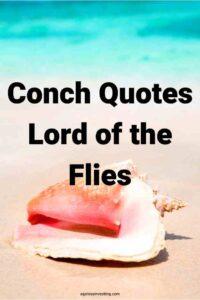The conch shell represents the fragile hold of order, democracy, and rational discourse among the stranded British schoolboys.
We’ve analyzed 18 crucial conch quotes with page numbers from William Golding’s Lord of the Flies. Organized chronologically by symbolic function, these quotes reveal its initial power, role in establishing rules, the challenges to its authority, and its tragic demise.
From its discovery as a tool to gather the scattered survivors to its violent shattering, the conch’s journey mirrors the boys’ descent from hopeful civilization into primal savagery.
The discovery of the conch provides the initial mechanism for creating order out of the chaos following the crash.
Discovery and the Call to Order (Chapter 1)
Piggy recognizes the conch’s potential, and Ralph wields it, establishing its power to summon and unite the boys, laying the foundation for their temporary society.
“S’right. It’s a shell! I seen one like that before… A conch he called it. He used to blow it and then his mum would come. It’s ever so valuable―”
(Character: Piggy, Chapter 1, Page 15)
Piggy’s immediate recognition links the conch to adult authority (“his mum would come”) and perceived value, establishing its significance beyond being a mere shell.
“His ordinary voice sounded like a whisper after the harsh note of the conch… the note, fluking up an octave, became a strident blare more penetrating than before.”
(Character: The narrator about Ralph blowing the conch, Chapter 1, Page 17)
The conch’s transformative power is immediate; it elevates Ralph’s presence and commands attention, silencing the island’s natural sounds.
“The conch was silent, a gleaming tusk; Ralph’s face was dark with breathlessness and the air over the island was full of bird-clamor and echoes ringing.”
(Character: The narrator, Chapter 1, Page 17)
Even in silence, the conch possesses a tangible presence (“gleaming tusk”), its recent sound still echoing, signifying its newfound importance.
“At last Ralph ceased to blow and sat there, the conch trailing from one hand, his head bowed on his knees. As the echoes died away so did the laughter, and there was silence.”
(Character: The narrator about Ralph, Chapter 1, Page 19)
The conch’s authority brings silence and attention, establishing its primary function as a tool for convening the group and pausing disorder.
“But there was a stillness about Ralph as he sat that marked him out… and most obscurely, yet most powerfully, there was the conch.”
(Character: The narrator, Chapter 1, Page 22)
The conch becomes intrinsically linked with Ralph’s authority, granting him a “powerful” legitimacy beyond his physical appearance.
“Let him be chief with the trumpet-thing.”
(Character: Anonymous boy supporting Ralph, Chapter 1, Page 22)
The boys intuitively connect the ability to wield the conch (“trumpet-thing”) with the right to leadership.
“I was with him when he found the conch. I was with him before anyone else was.”
(Character: Piggy asserting relevance, Chapter 1, Page 24)
Piggy attempts to leverage his proximity to the conch’s discovery to claim a place in the initial expedition, showing its early symbolic weight.
In the initial attempts to form a society, the conch becomes the central instrument for establishing rules, the democratic process, and the right to speak.
Establishing Rules and Democratic Order (Chapters 2 & 5)
Ralph and Piggy utilize the conch to implement parliamentary procedure, ensuring that meetings have structure and individuals have the right to be heard, mirroring civilized governance.
“Then I’ll give him the conch.” “Conch?” “That’s what this shell’s called. I’ll give the conch to the next person to speak. He can hold it when he’s speaking.”
(Dialogue: Ralph and Jack, Chapter 2, Page 33)
Ralph explicitly defines the conch’s primary rule: it grants the holder the right to speak without interruption, establishing a fundamental democratic principle.
“Ralph felt the conch lifted from his lap. Then Piggy was standing cradling the great cream shell and the shouting died down.”
(Character: The narrator, Chapter 2, Page 33)
Holding the conch confers authority and commands the group’s attention, momentarily silencing chaos.
“Piggy, partly recovered, pointed to the conch in Ralph’s hands, and Jack and Simon fell silent.”
(Character: The narrator about Piggy, Chapter 2, Page 34)
Even just referencing the conch held by the chief is enough to enforce the rule of silence, demonstrating its accepted power early on.
“Let him have the conch!” shouted Piggy. “Let him have it!”
(Character: Piggy advocating for the littlun, Chapter 2, Page 35)
Piggy champions the conch’s rule even for the weakest members, upholding the democratic principle that everyone deserves a chance to speak.
“Ralph shouted. Hear him! He’s got the conch!”
(Character: Ralph attempting to silence Jack, Chapter 5, Page 89)
Ralph invokes the conch’s power to try to regain control of the disintegrating assembly, reminding Jack of the established rules.
“If I blow the conch and they don’t come back; then we’ve had it… We’ll be like animals. We’ll never be rescued.”
(Character: Ralph to Piggy, Chapter 5, Page 92)
Ralph recognizes that the boys’ obedience to the conch is directly linked to their hope for rescue and status as civilized beings; its failure signifies their descent.
“I got the conch!”
(Character: Piggy asserting his right to speak, Chapter 5, Page 82)
Piggy repeatedly invokes the conch rule when interrupted, clinging to the principles of ordered debate even as others disregard them.
As Jack’s influence grows and savagery takes hold, the conch’s authority is openly challenged and ultimately dismissed, symbolizing the rejection of democratic principles.
The Decline and Destruction of Order (Chapters 6 – 11)
Jack’s increasing power is directly tied to his undermining and eventual rejection of the conch’s authority, culminating in its physical destruction alongside the murder of Piggy, the embodiment of reason.
“Conch! Conch!” shouted Jack. “We don’t need the conch anymore. We know who ought to say things…”
(Character: Jack, Chapter 6, Page 101-102)
Jack mocks the conch and explicitly rejects its necessity. He argues for an authoritarian system where power dictates who speaks, challenging Ralph’s democratic leadership. Analyse Jack’s quotes showing his rise to power.
“He laid the conch with great care in the grass at his feet. The humiliating tears were running from the corner of each eye. “I’m not going to play any longer. Not with you.””
(Character: The narrator about Jack leaving, Chapter 8, Page 127)
Even as Jack rejects Ralph’s leadership, his careful placement of the conch shows a lingering, perhaps subconscious, respect for the symbol he is about to abandon.
“The group of boys looked at the white shell with affectionate respect. Piggy placed it in Ralph’s hand and the littluns, seeing the familiar symbol, started to come back.”
(Character: The narrator, Chapter 8, Page 141)
Despite Jack’s departure, the conch still holds residual power and familiarity, representing comfort and order, especially for the younger boys.
“The rock struck Piggy a glancing blow from chin to knee; the conch exploded into a thousand white fragments and ceased to exist.”
(Character: The narrator, Chapter 11, Page 181)
The ultimate destruction of the conch is simultaneous with Piggy’s death. This violent act signifies the absolute end of civilization, democracy, and reason on the island, leaving only savagery.

The Conch: A Shattered Symbol
The conch shell in Lord of the Flies is far more than a simple tool; it’s the fragile vessel of civilization itself.
These quotes about the conch demonstrate its initial power to unite and establish order, its role as the cornerstone of the democratic process, and its tragic vulnerability in the face of rising fear and primal savagery.
Its final, explosive destruction marks the definitive triumph of chaos and the irretrievable loss of the boys’ civilized identities.
Explore the broader context of the island’s descent:
Discover All Lord of the Flies Quotes Analyses
A Note on Page Numbers & Edition:
These quotes track the conch’s fate, but page numbers will vary across editions. Where available, citations (e.g., Chapter 1, Page 15) reference the Penguin Books, December 16, 2003, Mass Market Paperback edition (ISBN-13: 978-0399501487). Always verify page numbers against your specific copy, especially for academic work, lest your citations become as fragmented as the conch itself.
